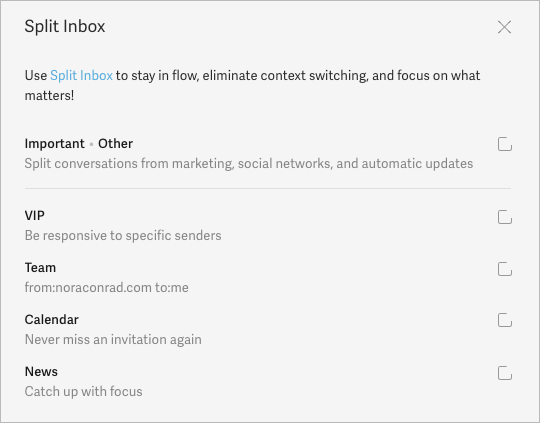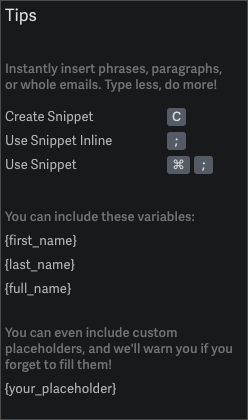Spending $30 per month on… email?
Superhuman — is it overhyped or worth the cost?
If you watch any productivity channel on YouTube, you likely have heard about the $30 per month email client that seems all over the place: Superhuman.
Superhuman is a super fast email client that allows you to connect Gmail and Outlook emails into their platform. It claims to save you hours a month on emails and is loved by many big creators; Ali Abdaal, Francesco D'Alessio, and Tiago Forte — the list goes on.

I’ve been having some trouble finding an email solution that I like, and I’ve tried many of them, these three being the most recent.
- Gmail (combined all into one account)— the best option so far, but it is not very pretty, and I easily get distracted because of the plugins and apps I use. It's also overwhelming to look at when I’m not at inbox zero.
- Spark Mail — It was fine, but it was really slow on my phone and often didn’t sync well with one account in particular. I felt like there were too many features I was settling for and not loving.
- Canary Mail — I can’t get past some of the bugs I was experiencing. From all my font colors being stuck to white to emails I deleted weeks ago magically reappearing, it was annoying. I liked the app quite a bit, but nothing incredible keeps me hooked enough to deal with some of the weird issues.
After adding ANOTHER email to my growing collection (one personal, two business, two clients, one school, one family, and one volunteer), I had to start looking for a new solution, and of course — Superhuman kept popping up.
I recently shared the list of nearly $1,700 subscriptions I pay for every year, and upon reflection, email is one of the places I spend most of my time. I figured I could sacrifice one of my many subscriptions if Superhuman worked as well as I hoped it would.
What could possibly justify this price tag?
Every video I’ve seen about Superhuman seemed ~vague~ on what made this platform so special. I knew it was fast and focused on using keyboard shortcuts, but is that it?
I spent well over an hour watching tutorials, interviews, and recommendations before giving up and just signing up for a free month with an affiliate link I found.
Quick shameless plug for my affiliate link: if you want to try a free month, you also give me a free month. Thanks ;)
Here’s what I noticed about the platform right away that I would say contributes to their price tag:
Onboarding Process
You get the chance to try out their primary shortcuts on practice emails. I love that they do this so you get a quick intro to the app without altering your current inbox. It’s simple, but not knowing how to navigate a new tool often loses the user faster than features or bugs.

The onboarding takes less than five minutes, but small tips are scattered throughout the menus as you begin to use the tool. This makes it easy to learn and to begin using.
Easy Keyboard Shortcuts
I don’t know if you’ve ever used the Gmail shortcuts, but there are many of them. You can open up a menu to get a cheat sheet, but it’s a lot of information and can be overwhelming. Superhuman has a command line shortcut — Cmd+K or Ctrl+K — that gives you quick access to all the shortcuts, and it gently reminds you of what shortcut you could be using when you opt for mouse clicks.

The reminders are subtle enough not to be annoying but easily accessible enough actually to reference and learn. Properly educating your users on keyboard shortcuts is a key feature that very few software include. I appreciate how well this is done and how beautifully it’s designed in the UI.
Command Line
I am a huge fan of Raycast (Alfred for you PC users), and I have grown fond of a command line access bar for apps. Sunsama recently rolled this out, and Raycast is probably one of the most used apps on my computers. So, I have to give huge props to Superhuman for integrating command-line actions into their platform and doing it SO well. It’s fast, it’s easy to search through, and it uses natural language so that you can easily find the setting you’re looking for.
The User Interface
In the same way we pay for pretty cars, homes, and different colored phones, I pay for well-designed apps. There is a lot to be said about great interface design when it comes to Superhuman. The inbox zero page is inspiring and rewarding. The contact sidebar is clean and easy to use. The emails themselves look great on the page. The buttons and options are easy to find but well integrated for a clean, minimal look. Overall, it’s a calm space to work through massive data.
The contact pane includes data from Clearbit, giving you a look at the person based on public social media details and links to the five most recent emails for easy reference.
Split Inbox
Much like Gmail’s Inbox Type and Category settings, Superhuman offers a similar auto-sorting of your emails. The biggest difference is that Superhuman does this well. I’ve always kept my inbox in gmail as primary only, because important emails often get lost in the sea of “promotions”.

Superhuman’s sorting is really really really good. It also offers better default category options like Google Docs, Notion, or Asana emails, so you can find emails faster and make time for specific focuses during the day. You can easily add new splits by hitting the Cmd+K or Ctrl+K, then New Split Inbox. From here, you can create the new split based on the email address, domain, recipient, or subject. You can create a new name, and now a new split is added.

If you like Gmail’s existing categories and rely on them, you can create splits based on the Gmail categories.
Snippets (aka templates)
This might be a winning feature if you find yourself writing the same kind of emails repeatedly. Unlike Gmail’s clunky and often buggy templates, Superhuman’s snippets feature is well thought out. From variables like {first_name} or even {your_placeholder}, to the ease of inserting and using these, Superhuman stands out among the crowd.

Biggest problems so far
Besides the large price tag, Superhuman has a few features (or lack thereof) that I was disappointed with.
No unified inbox
While I like being able to split my emails up to focus on different areas of my life at different times, there are many times when I am casually checking my email and would like to see all my inboxes combined rather than clicking through my eight email accounts to see if there’s anything new. This lacking option is almost a deal breaker for me, especially when you consider the company’s “workaround” on their help pages.
No way to edit existing folders or labels
You have to log in to Gmail or Outlook to do this; frankly, it’s annoying. Their split feature paired with the great search is likely meant to replace this feature completely, but I still use Gmail on my work computer, so I really need a solution that converts well between my Gmail account and superhuman email.
No Vacation Mode or Out of Office Settings
Again, this feature has yet to be added to Superhuman and needs to be edited directly in the individual Outlook or Gmail accounts. They offer the shortcut Cmd+K or Ctrl+K followed by OOO to go straight to the account settings, but I wish this were a native option, especially when it’s native to almost every other email app I’ve used.
The big question: Is it worth it?
Yes. An expensive but resounding yes. Superhuman’s features may seem subtle, but the overall experience is hard to put into words or screenshots.
It goes beyond functionality; it makes dealing with email enjoyable and easy. While the price tag may initially raise eyebrows, the intangible benefits of a well-designed, efficient email platform make Superhuman a worthwhile investment if it’s in your budget.
Personally, I’m reluctantly thrilled to admit that I’m hooked. The dilemma lies in the fact that I am now compelled to shell out the money to continue using this remarkable tool. If you’re ready to dent your wallet but achieve that elusive inbox zero, take Superhuman for a test spin with my affiliate link for a free month (hey, it softens the financial blow, and I won’t say no to a discount).
